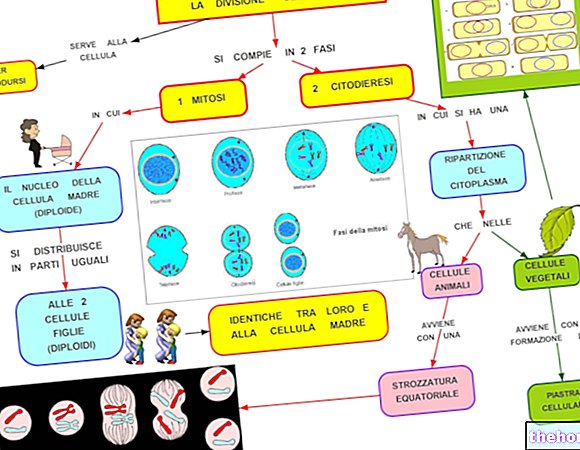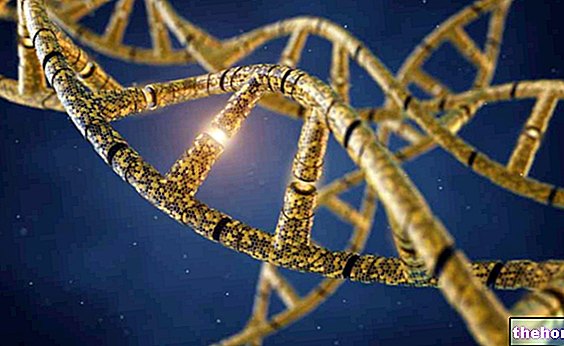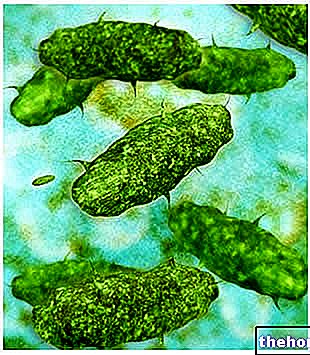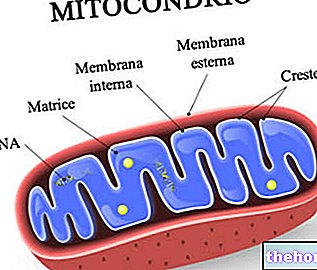Generality
Nucleic acids are the large biological molecules DNA and RNA, the presence and proper functioning of which, within living cells, are essential for the survival of the latter.
A generic nucleic acid derives from the union, in linear chains, of a large number of nucleotides.

Figure: DNA molecule.
Nucleotides are small molecules, in whose constitution three elements participate: a phosphate group, a nitrogenous base and a 5-carbon sugar.
Nucleic acids are vital for the survival of an organism, as they cooperate in the synthesis of proteins, molecules essential for the correct implementation of cellular mechanisms.
DNA and RNA differ from each other in some respects.
For example, DNA has two antiparallel nucleotide chains and has deoxyribose as a 5-carbon sugar. RNA, on the other hand, usually has a single chain of nucleotides and possesses ribose as a sugar with 5 carbon atoms.
What are nucleic acids?
Nucleic acids are the biological macromolecules DNA and RNA, the presence of which, inside the cells of living beings, is essential for the survival and correct development of the latter.
According to another definition, nucleic acids are biopolymers resulting from the union, in long linear chains, of a large number of nucleotides.
A biopolymer, or natural polymer, is a large biological compound made up of molecular units that are all the same, which are called monomers.
NUCLEIC ACIDS: WHO IS IN POSSESSION?
Nucleic acids reside not only within the cells of eukaryotic and prokaryotic organisms, but also in acellular life forms, such as viruses, and in cellular organelles, such as mitochondria and chloroplasts.
General structure
Based on the above definitions, nucleotides are the molecular units that make up the nucleic acids DNA and RNA.
Therefore, they will represent the main topic of this chapter, devoted to the structure of nucleic acids.
STRUCTURE OF A GENERIC NUCLEOTIDE
A generic nucleotide is a compound of organic nature, the result of the union of three elements:
- A phosphate group, which is a derivative of phosphoric acid;
- A pentose, that is, a sugar with 5 carbon atoms;
- A nitrogenous base, which is an aromatic heterocyclic molecule.
The pentose represents the central element of the nucleotides, as the phosphate group and the nitrogenous base bind to it.

Figure: Elements that make up a generic nucleotide of a nucleic acid. As can be seen, the phosphate group and the nitrogen base bind to the sugar.
The chemical bond that holds the pentose and the phosphate group together is a phosphodiester bond, while the chemical bond that binds the pentose and the nitrogenous base is an N-glycosidic bond.
HOW DOES THE PENTOSE PARTICIPATE IN THE VARIOUS LINKS WITH THE OTHER ELEMENTS?
Premise: chemists have thought of numbering the carbons that make up organic molecules in such a way as to simplify their study and description. Here, then, that the 5 carbons of a pentose become: carbon 1, carbon 2, carbon 3, carbon 4 and carbon 5.
The number assignment criterion is quite complex, therefore we consider it appropriate to leave out the explanation.
Of the 5 carbons that form the pentose of the nucleotides, those involved in the bonds with the nitrogenous base and the phosphate group are, respectively, carbon 1 and carbon 5.
- Pentose carbon 1 → N-glycosidic bond → nitrogen base
- Pentose carbon 5 → phosphodiester bond → phosphate group
WHAT KIND OF CHEMICAL BOND BINDING THE NUCLEOTIDES OF NUCLEIC ACIDS?

Figure: Structure of a pentose, numbering of its constituent carbons and bonds with nitrogen base and phosphate group.
In composing nucleic acids, nucleotides organize themselves into long linear chains, better known as filaments.
Each nucleotide forming these long strands binds to the next nucleotide by means of a phosphodiester bond between the carbon 3 of its pentose and the phosphate group of the immediately following nucleotide.
THE EXTREMITIES
Nucleotide strands (or polynucleotide strands), which make up nucleic acids, have two ends, known as 5 "end (read" five prime ") and 3" end (read "three prime"). By convention, biologists and geneticists have established that "end 5" represents the head of a strand forming a nucleic acid, while "end 3" represents its tail.
From the chemical point of view, the "5 end" of the nucleic acids coincides with the phosphate group of the first nucleotide of the chain, while the "3 end" of the nucleic acids coincides with the hydroxyl (OH) group on carbon 3 of the last nucleotide .
It is on the basis of this organization that, in the books of genetics and molecular biology, the nucleotide strands of a nucleic acid are described as follows: P-5 "→ 3" -OH.
* Note: the letter P indicates the phosphorus atom of the phosphate group.
Applying the concepts of 5 "end and 3" end to a single nucleotide, the "5 end" of the latter is the phosphate group bonded to carbon 5, while its 3 "end is the hydroxyl group joined to carbon 3.
In both cases, s "invites the reader to pay attention to the numerical recurrence: end 5" - phosphate group on carbon 5 and end 3 "- hydroxyl group on carbon 3.
General function
Nucleic acids contain, transport, decipher and express genetic information in proteins.
Made up of amino acids, proteins are biological macromolecules, which play a fundamental role in regulating the cellular mechanisms of a living organism.
The genetic information depends on the sequence of nucleotides, which make up the strands of nucleic acids.
Hints of history
The credit for the discovery of nucleic acids, which took place in 1869, goes to the Swiss physician and biologist Friedrich Miescher.
Miescher made his findings while he was studying the cell nucleus of leukocytes, with the intention of better understanding their internal composition.
Miescher's experiments represented a turning point in the field of molecular biology and genetics, as they initiated a series of studies that led to the identification of the structure of DNA (Watson and Crick, in 1953) and of RNA, to the knowledge of mechanisms of genetic inheritance and the identification of the precise processes of protein synthesis.
ORIGIN OF THE NAME
Nucleic acids have this name, because Miescher identified them within the nucleus of leukocytes (nucleus - nucleic) and discovered that they contained the phosphate group, a derivative of phosphoric acid (derivative of phosphoric acid - acids).
DNA
Among the known nucleic acids, DNA is the most famous, as it represents the storehouse of genetic information (or genes) that serve to direct the development and growth of the cells of a living organism.
The abbreviation DNA means deoxyribonucleic acid or deoxyribonucleic acid.
DOUBLE HELIX
In 1953, to explain the structure of the "nucleic acid DNA, the biologists James Watson and Francis Crick proposed the model - which later turned out to be correct - of the so-called" double helix ".
According to the "double helix" model, DNA is a large molecule, resulting from the union of two long strands of antiparallel nucleotides and coiled into one another.
The term "antiparallel" indicates that the two filaments have opposite orientation, that is: the head and tail of one filament interact, respectively, with the tail and the head of the other filament.
According to another important point of the "double helix" model, the nucleotides of the DNA nucleic acid possess such an arrangement that the nitrogenous bases are oriented towards the central axis of each spiral, while the pentoses and phosphate groups form the scaffold. external of the latter.
WHAT IS THE PENTOSE OF DNA?
The pentose that makes up the nucleotides of the DNA nucleic acid is deoxyribose.
This 5-carbon sugar owes its name to the lack of oxygen atoms on carbon 2. After all, deoxyribose means "free of oxygen".

Figure: deoxyribose.
Due to the presence of deoxyribose, the nucleotides of the DNA nucleic acid are called deoxyribonucleotides.
TYPES OF NUCLEOTIDES AND NITROGEN BASES
DNA nucleic acid has 4 different types of deoxyribonucleotides.
To distinguish the 4 different types of deoxyribonucleotides is only the nitrogen base, linked to the pentose-phosphate group formation (which unlike the nitrogen base never varies).
For obvious reasons, therefore, the nitrogenous bases of DNA are 4, specifically: adenine (A), guanine (G), cytosine (C) and thymine (T).
Adenine and guanine belong to the class of purines, double ring aromatic heterocyclic compounds.
Cytosine and thymine, on the other hand, fall into the category of pyrimidines, single-ring aromatic heterocyclic compounds.
With the "double helix" model, Watson and Crick also explained what is the organization of the nitrogenous bases inside the DNA:
- Each nitrogenous base of a filament joins, by means of hydrogen bonds, a nitrogenous base present on the antiparallel filament, effectively forming a pair, a pairing, of bases.
- The pairing between the nitrogenous bases of the two filaments is highly specific. In fact, adenine only binds to thymine, while cytosine only binds to guanine.
This important discovery led molecular biologists and geneticists to coin the terms of "complementarity between nitrogenous bases" and "complementary pairing between nitrogenous bases", to indicate the uniqueness of binding of adenine with thymine and cytosine with guanine. .
WHERE DOES IT RESIDE INSIDE THE LIVING CELLS?
In eukaryotic organisms (animals, plants, fungi and protists), the DNA nucleic acid resides within the nucleus of all cells having this cellular structure.
In prokaryotic organisms (bacteria and archaea), however, the DNA nucleic acid resides in the cytoplasm, since prokaryotic cells lack the nucleus.

RNA
Between the two nucleic acids existing in nature, RNA represents the biological macromolecule that translates the DNA nucleotides into the amino acids constituting the proteins (protein synthesis process).
In fact, nucleic acid RNA is comparable to a dictionary of genetic information, reported on nucleic acid DNA.
The abbreviation RNA means ribonucleic acid.
DIFFERENCES THAT DISTINGUISH IT FROM DNA
Nucleic acid RNA has several differences compared to DNA:
- RNA is a smaller biological molecule than DNA, usually made up of a single strand of nucleotides.
- The pentose that makes up the nucleotides of ribonucleic acid is ribose. Unlike deoxyribose, ribose has an oxygen atom on carbon 2.
It is due to the presence of the ribose sugar that biologists and chemists have assigned the name of ribonucleic acid to RNA. - RNA nucleotides are also known as ribonucleotides.
- Nucleic acid RNA shares only 3 out of 4 nitrogenous bases with DNA. In fact, instead of thymine, it has the nitrogenous base uracil.
- RNA can reside in various compartments of the cell, from the nucleus to the cytoplasm.
TYPES OF RNA

Figure: ribose.
Within living cells, nucleic acid RNA exists in four main forms: transport RNA (or RNA transfer or tRNA), messenger RNA (or RNA messenger or mRNA), ribosomal RNA (or ribosomal RNA or rRNA) and the small nuclear RNA (o small nuclear RNA or snRNA).
Although they play different specific roles, the four aforementioned forms of RNA cooperate for a common goal: the synthesis of proteins, starting from the nucleotide sequences present in the DNA.
Artificial models
In recent decades, molecular biologists have synthesized, in the laboratory, several nucleic acids, identified with the adjective "artificial".
Among the artificial nucleic acids, the TNA, the PNA, the LNA and the GNA deserve a particular mention.









.jpg)


















